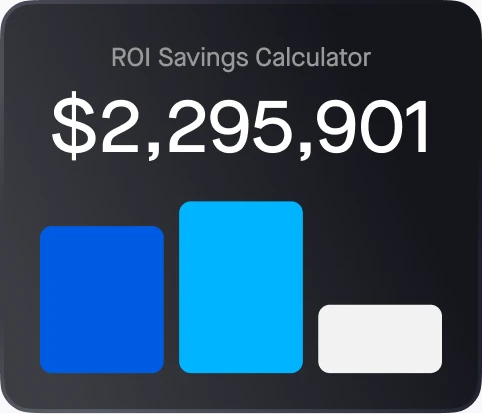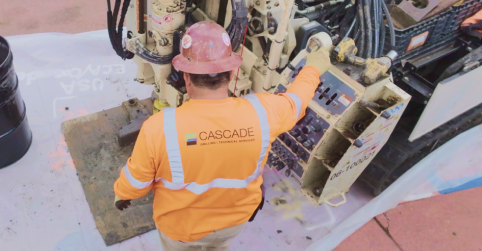- Introduction
- 2025: The year AI goes to work for you
- The basics: The different types of AI
- Trend #1: AI automation and agentic AI
- Trend #2: One platform, one team
- Trend #3: AI accuracy and benchmarking
- Trend #4: Rapid expansion of computer vision applications
- Trend #5: AI is reshaping back-office operations
- Act now: How to get the most from AI
- The future of AI is now
Introduction
In just a short time, artificial intelligence (AI) has shifted from hype to real-world impact, transforming industries at an unprecedented pace. For physical operations leaders, AI isn’t just an advantage — it’s a necessity.
The physical economy — powered by fleets — is moving forward on AI investment, integrating AI into operations where it matters most. From reducing accidents with computer vision to reducing back-office inefficiency through automation, fleets are seeing measurable, bottom-line results.
The businesses adopting AI today aren’t just staying competitive — they’re shaping the future of this transformative technology.
Why the physical economy is adopting AI faster than the digital economy
Industries that move the physical economy — trucking, construction, energy, utilities, field services, and many more — operate in high-risk, high-cost environments where safety, efficiency, and profitability are constantly at odds.
While the digital economy debates the return on investment they get from AI, physical operations leaders are deploying it at scale, because its impact is immediate and measurable. Where the digital economy thrives on data and software, the physical economy runs on skilled labor, vehicles, and equipment — and that’s exactly where AI is making the biggest difference.
AI in fleet management and job site operations is being funded by COOs and CFOs out of their core operations budgets. Why? Because the need is urgent and the ROI is undeniable.
Enterprise fleets are embracing AI to drive safety and efficiency
With lower costs and greater accessibility, enterprise fleets are adopting AI at record speed. Spending on generative AI surged 500% last year, reaching $13.8 billion — up from just $2.3 billion in 2023. Of the many leaders who have invested, 47% of C-suite executives say they want their businesses to develop generative AI tools faster, even though 69% started investing more than a year ago.
With so much demand, AI could contribute up to $15.7 trillion to the global economy by 2030, more than the current output of China and India combined. Motive’s Physical Economy Outlook shows how quickly momentum is building across physical operations:
- 76% of physical operations leaders want AI-powered visibility across their businesses.
- 74% say AI is critical to cutting costs and increasing efficiency.
- 73% agree that AI-powered dash cams make roads safer.
- 71% are integrating generative AI into daily operations.
2025: The year AI goes to work for you
AI has grown exponentially since 2010, when the computational power needed to train AI models started doubling. Digital transformation brought physical operations online, and the last decade has been focused on giving leaders visibility on the road, in the field, and the back office. But visibility isn’t enough — tracking and visibility are table stakes.
The challenge now is managing overwhelming amounts of data. Critical safety and coaching tasks are still too manual, and finance teams are unable to stop fraud and wasteful spending at scale. As tools and workflows struggle to keep pace with rising fleet demands, safety, operations, and finance teams must sift through thousands of unstructured data points, looking for ways to improve fleet safety, productivity, and profitability.
That’s where 2025 will bring the most transformation. Leaders will be able to make sense of their data much faster, turning insights into action through AI-powered automation.
The 5 AI trends shaping fleet management in 2025
- Automation and Agentic AI – AI-driven automation will eliminate tedious administrative tasks, giving teams critical time back in their day.
- One Platform, One Team – Fleets are consolidating operations onto AI-powered platforms, fostering greater cohesion and efficiency across teams.
- AI Accuracy and Benchmarking – Computer vision is becoming the gold standard for fleet safety, which will drive demand for transparency, benchmarking, and model accuracy to ensure that life-saving technology performs as promised.
- Rapid Expansion of Computer Vision Applications – Computer vision is delivering measurable ROI in fleet safety, and new use cases will explode as a result.
- AI Reshaping Back-Office Operations – AI will deliver significant, measurable ROI in back-office functions by preventing fraud, improving efficiency, and transforming fleet management beyond just risk reduction.
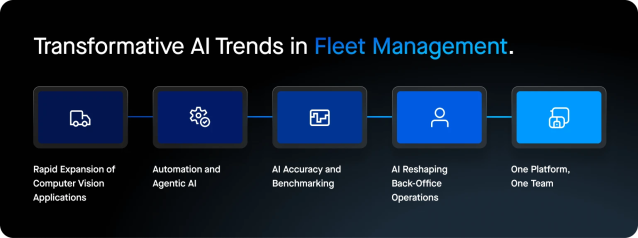
The basics: The different types of AI
AI is an umbrella term that encompasses multiple technologies, each with distinct capabilities and applications. But there’s much more to it than that. Understanding the different types of AI is key to identifying how it can be applied to your business. Whether it’s natural language processing, computer vision, or generative AI, each category serves a unique role in transforming workflows, decision-making, and automation.
So what is AI? What types exist, and how are they used? Here are some basics to get you started:
| Type of AI | What It Does | Why It Matters for Fleets |
|---|---|---|
| AI (Artificial Intelligence) | AI refers to the imitation of human intelligence in machines, allowing them to perform tasks that typically require human cognition, such as machine learning, natural language processing, computer vision, and deep learning. | AI is getting smarter fast, able to complete more complex tasks. The next big breakthrough will be AI’s ability to think through problems step by step rather than just recognize patterns or answer simple questions. Advanced models like Gemini 2.0 Flash Thinking Mode and OpenAI’s o1 function not just as information retrieval tools but as thought partners, bringing a more human-like approach to AI-powered interactions. |
| Large Language Models (LLMs) | AI models trained to understand and generate human-like text, powering tools like ChatGPT. | LLMs help automate workflows, analyze data, and improve driver and customer interaction. Multi-task models like these are trained on diverse datasets that span a wide range of domains, styles, and tasks. |
| Computer Vision | AI that processes and interprets visual data from cameras and sensors in real time. | Computer vision detects unsafe driving behaviors, identifies job site hazards, and tracks assets, helping reduce risk and improve efficiency. |
| Generative AI | Generative AI (Gen AI) creates new content (text, images, videos) based on patterns learned from existing content and training data. | Gen AI helps fleets analyze trends, generate reports, and develop AI models for driver monitoring and safety applications. |
| Physical AI | AI integrated with sensors and cameras to interact with and understand real-world environments. | Physical AI powers autonomous vehicles, predictive maintenance, and advanced robotics and automation, leading to safer and more efficient operations. |
| AI Agents (Agentic AI) | AI systems that independently manage tasks, learn from interactions, and make real-time decisions. | AI agents help automate fleet processes, such as analyzing data, generating reports, detecting fraud, and coaching drivers. |
Now that we have an understanding of the different types of AI and how they’re applied, let’s dive into how they’re shaping the physical economy.
Trend #1: AI automation and agentic AI
AI isn’t just analyzing data — it’s acting on it. Fleets are adopting agentic AI systems that can automate decision-making, eliminate tedious administrative work, and free up time in their day.
For decades, managing a physical business and workforce meant sifting through paperwork, chasing down missing information, and relying on manual oversight. Managers spent valuable time searching for a single detail that could make or break their margins, while others worked late into the night tracking down expensive, misplaced equipment. Not anymore.
The rise of automation and agentic AI is making teams much more productive, showing that the future of fleet operations isn’t about working harder — it’s about working smarter.
AI agents are advanced systems that manage tasks, learn, and make decisions independently. In fleet and physical operations, they reduce risk, boost efficiency, and cut costs — working as virtual assistants 24/7 on your behalf. For example:
- AI-Powered Driver Coaching – AI monitors real-time driving behavior and provides instant, in-cab feedback (alerting a driver to distracted driving, harsh braking, or lane drifting, for example) to improve safety without human intervention.
- Proactive Maintenance Scheduling – AI predicts vehicle breakdowns based on sensor data and automatically schedules maintenance before a failure occurs, resulting in reduced risk, costs, and downtime.
- Automated Incident Response – AI detects a collision with extreme accuracy and autonomously triggers a workflow, such as notifying fleet or safety managers and routing to the appropriate first responder in the event of a severe incident to get help faster.
- Dynamic Route Optimization – Machine learning algorithms analyze real-time data like traffic conditions, vehicle location, and delivery schedules to generate the safest and most efficient routes for fleet vehicles.
- Fraud Detection & Prevention – AI identifies and prevents fraudulent transactions by analyzing vehicle location data alongside transaction details to detect discrepancies and flag or auto-decline suspicious activity in real time.
Trend #2: One platform, one team
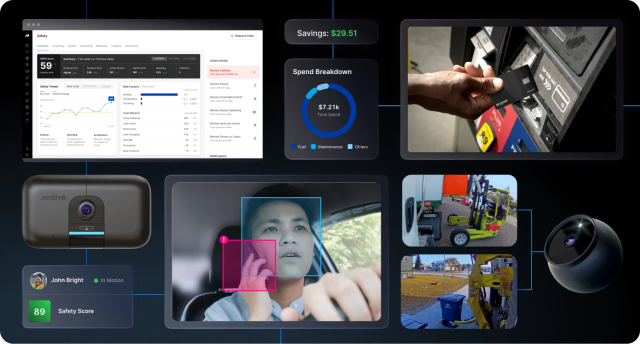
Fleets are consolidating operations onto AI-powered platforms, fostering greater cohesion and efficiency across teams.
Instead of juggling multiple disconnected systems, businesses are consolidating operations onto AI-powered platforms that unify workflows and maximize efficiency. By eliminating inefficiencies and improving collaboration, AI provides real-time insights across entire operations, ensuring that:
- Safety managers can automate driver coaching without manual intervention.
- Operations teams can track vehicles, equipment, and spend in one place.
- Finance teams can prevent fraud, respond faster to suspicious activity, and reduce wasteful spending.
A shift toward all-in-one AI solutions
Motive’s Physical Economy Outlook found that 80% of leaders agree that having a single, end-to-end solution to manage physical operations would make their jobs easier. Today’s customers demand AI-powered platforms that give them vital visibility and let them manage all their operations in a single frame.

The business case for AI centralization
All Chemical Transport Corp, a leader in hazardous and non-hazardous bulk liquid transport, struggled with disconnected fleet and spend management systems, which left them with limited visibility and control over their operations.
By adopting the Motive AI-powered platform, including AI Dashcams, AI Omnicams, Vehicle Gateways, Asset Gateways, Telematics Systems, and the Motive Card, All Chemical unified safety, fleet management, equipment monitoring, and spend tracking — gaining unmatched visibility and control.
“We’re able to save a considerable amount of time utilizing the Motive Card, AI Dashcams, and the AI Omnicam right in the same platform with the telematics and other driver analytics,” says Anthony Coruccini, Chief Operations Officer for All Chemical. “It’s all tied together, giving us a better and more reliable source of information – so we can make better decisions in every corner of the business.”
Trend #3: AI accuracy and benchmarking
Computer vision is becoming the gold standard for fleet safety, which will drive demand for transparency, benchmarking, and model accuracy to ensure that life-saving technology performs as promised.

40,990. That’s the number of people who died in vehicle-related accidents last year in the U.S. alone. Road accidents were a leading cause of death for people 54 and under. With so many lives lost, this epidemic of road deaths hasn’t received the attention it deserves. Sadly, the problem is getting worse, not better.
For fleet operators, the cost of these accidents is both personal and professional. Putting vehicles on the road with so much at stake is a tremendous responsibility. Anything can happen at any time, and safety managers are under constant pressure to keep their people safe.
When a collision occurs, the cost of an accident is just beginning. There’s vehicle damage, medical bills, and potential litigation to worry about, not to mention the welfare of those involved. AI-powered cameras are helping to prevent accidents and lives lost. AI gives us a chance to really impact the safety of our roadways, but to make a difference, commercial fleets need accurate, reliable AI that detects and alerts to unsafe driving behavior in real time.
Finding a technology provider with an in-house team of human reviewers adds a critical layer of verification, ensuring that AI insights are precise, accurate, and free from false positives. This human-AI collaboration helps fleets focus on the safety events that truly matter, preventing distractions and improving response times.
AI accuracy determines life or death on the road
Accurate AI detection is crucial – it’s the difference between preventing an accident and picking up the pieces after it happens. Using AI to detect risk in real time can fend off injury, prevent accidents, and create a more achievable path to Zero Harm. Motive data shows that fleets that use accurate AI can reduce safety events by more than 90% within six months.
Business leaders must balance rapid innovation with developing customer trust by participating in transparent AI benchmarking for the most high-risk and consequential areas. This is particularly true when it relates to the safety of your workforce and the overall community.
Would you get behind the wheel of a truck that failed a basic safety test? Then why would you trust AI that hasn’t been rigorously tested for accuracy?
To increase trust and transparency, the industry will push for standardized benchmarks for AI accuracy, much like we’ve seen with large language models (LLMs). AI benchmarking is the process of evaluating AI models and systems against specific tasks using defined parameters and datasets. This verification ensures that a product performs as claimed.
Evaluating AI dash cams? Demand proof before you buy.
If you’re in the market for a new AI-powered dash cam, don’t settle for marketing claims — demand hard data. Ask for benchmarking results and insist on full transparency from vendors about their AI accuracy, detection speed, and false positive rates.
Better yet, run your own trial. Put the technology to the test in real-world conditions to see how well it detects risk, prevents incidents, and outperforms competitors. The right AI dash cam doesn’t just record — it protects.
Trend #4: Rapid expansion of computer vision applications
Computer vision is delivering measurable ROI in fleet safety, and new use cases will explode as a result.
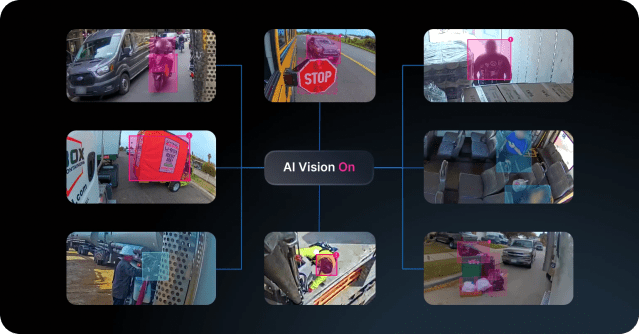
Everyone is wondering whether the massive investments in AI — trillions of dollars over the next few years, according to Goldman Sachs — will actually deliver meaningful returns. So far, the results have been mixed. Critics point to an MIT study predicting that AI will contribute just 1% to GDP growth over the next decade, with the biggest financial gains currently going to hardware providers powering AI advancements.
While much of the conversation has centered around AI’s role in automating knowledge work through models like ChatGPT and Gemini, the impact of this technology goes far beyond that. Fleet operators are already seeing AI drive significant ROI, particularly through computer vision, which enhances human perception and execution in ways that were previously impossible.
While its impact is massive, computer vision is still underutilized. In Motive’s State of Safety Report, for example, less than a quarter of respondents said they use AI-powered cameras. Meanwhile, roadways remain deadly, with nearly 41,000 fatalities in 2023.
But the ROI of computer vision is real, and we’ll see demand skyrocket as a result.
Fleet operators are already seeing AI’s impact where it matters most: the bottom line. AI-powered vision systems are cutting at-fault accidents by up to 91%, saving fleets millions in legal fees, insurance claims, and operational downtime. While some AI investments struggle to show returns, computer vision is proving its value today — helping fleets reduce risk, improve safety, and protect their workforce.

The financial case for computer vision
Ernst Concrete, a leading ready-mix concrete provider, transformed its safety program with Motive dual-facing AI Dashcams and video-based coaching. In just 13 months, the company achieved the following:
- 2,000% return on investment
- $6.5M in estimated savings
- 97% reduction in cell phone use
- 81% reduction in close following events
- 83% reduction in distracted driving events.
These results underscore why computer vision is becoming so essential for fleet operations. With tools like AI dash cams and 360-degree cameras, fleets can detect distracted driving, close following, sideswipes, and other unsafe driving behaviors with up to 99% accuracy.
The numbers above aren’t just statistics. They represent lives saved, costs avoided, and more profitable, efficient operations. Here are other examples of how computer vision is enhancing safety and compliance in physical operations.
The expanding use cases of computer vision in safety and efficiency
AI Face Match
The most time-consuming part of managing unidentified trips is often figuring out who was driving. AI-powered driver identification tools automatically match drivers to unidentified trips, reducing administrative work and ensuring that the right driver is identified.
(Not available in Illinois)
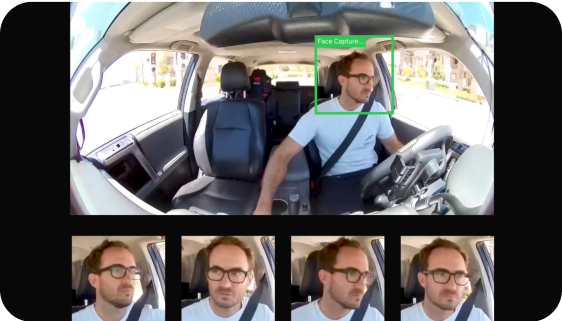
Collision Detection
AI-powered collision detection instantly detects crashes and alerts managers, allowing for a faster emergency response. Today’s AI models detect crashes of all severity levels so nothing gets missed.
Lorem ipsum dolor sit amet.
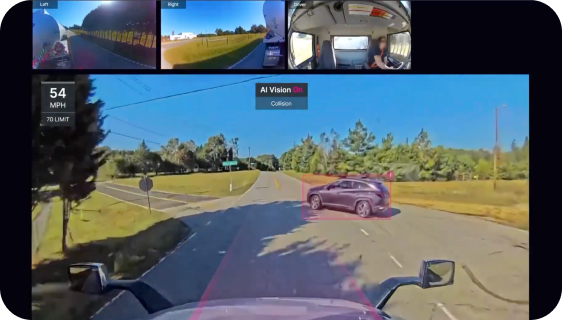
AI-Powered Positive Driving Recognition
Positive driving recognition identifies and rewards safe driving behaviors, improving driver retention, morale, and engagement. As AI plays a greater role in fleet safety, the human element remains indispensable.
Lorem ipsum dolor sit amet.
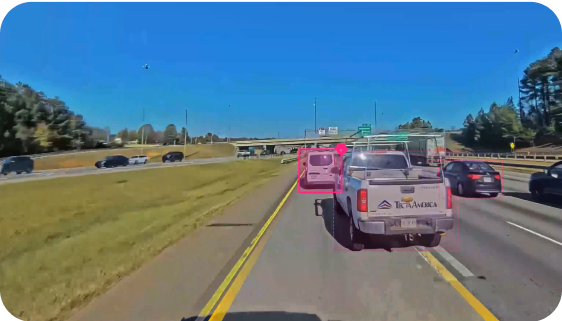
Unsafe Parking Alerts
AI-powered unsafe parking alerts flag vehicles parked dangerously on the highway, reducing the risk of high-speed roadside accidents.
Lorem ipsum dolor sit amet.
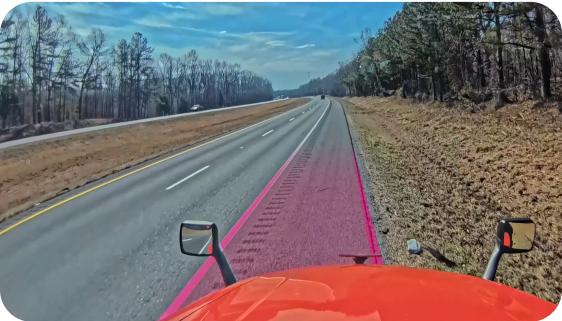
Fatigue Monitoring
Fatigue monitoring uses AI to analyze signs of drowsy driving and accurately detect fatigue before it leads to a crash. Behaviors like lane swerving, absence of movement, and frequent yawning are all red flags.
Lorem ipsum dolor sit amet.

Features like these offer more than convenience. They prevent accidents, improve response times, and save lives across industries. For enterprise customers, the gains from AI have been most impactful, generating ROI of 2,000% and $6.5 million in savings in some cases.
Trend #5: AI is reshaping back-office operations
AI will deliver significant, measurable ROI in back-office functions by preventing fraud, improving efficiency, and transforming fleet management beyond risk reduction.

AI transforms back-office operations
For years, commercial fleets have navigated the burden of time-consuming administrative tasks. Manual processes slowed operations, increased labor demands, and created opportunities for costly human error. AI is changing that.
By automating complex and tedious workflows, AI is streamlining back-office operations, preventing fraud, and delivering measurable improvements in efficiency and productivity. In return, fleet managers are getting back valuable time, with AI handling everything from compliance reporting to driver coaching.
Instead of sifting through paperwork and manually entering data, teams can now rely on AI-powered systems that instantly extract, process, and upload critical information. The impact is clear.
While driver safety remains a top priority, AI is revolutionizing the back office, eliminating inefficiencies that once slowed operations. AI-powered workforce management solutions do the heavy lifting themselves, so fleet managers don’t have to track countless documents by hand. Compliance records, driver qualification files, fuel receipts — all previously managed through tedious manual processes — are now handled seamlessly.
Enterprise fleets managing hundreds of drivers can now manage thousands of documents automatically, transforming what was once a monumental challenge into a streamlined, error-free process.
Fraud detection and risk management
AI’s back-office impact extends far beyond document management. Fraud detection is becoming an increasingly urgent priority as financial crimes grow in sophistication. Up to 19% of fleet spend is lost to these crimes, and nearly 45% of business leaders say fraud is having a major financial impact on their operations.
In a single year, 96% of U.S. companies were targeted by at least one fraud attempt. Even friendly fraud — where transactions appear legitimate but later turn out to be unauthorized — is rising. More than 60% of merchants have reported an increase in friendly fraud since 2022, making it the second most common type of fraud today.
Fortunately, AI-powered fraud controls are giving finance leaders the power to fight back. By leveraging automation and real-time data, AI can automatically identify fraudulent transactions, flag suspicious activity, and enforce spending controls before losses mount.
For example, when Motive’s fraud detection capabilities were in early release and deployed to only a handful of fleets, they saved customers $250,000 in just 30 days by blocking over 1,200 unauthorized transactions. AI-powered fraud detection gives finance teams full visibility into spending, pinpointing anomalies the instant they arise.
As finance leaders enter 2025, they face rising challenges in cost control, risk mitigation, and talent management. The pressure to modernize operations has never been greater, and AI is now a fundamental part of the solution.
According to Deloitte’s CFO Signals survey, nearly 46% of finance leaders plan to increase investment in generative AI, reinforcing its role in reducing financial leakage, automating workflows, and improving decision-making. By eliminating hours of manual work, AI frees finance teams to focus on higher-value initiatives — shifting their role from process management to strategic leadership.
Analytics: The key to smarter operations
At the core of these advancements is AI-powered analytics. Managing fleet operations means dealing with massive amounts of data — safety events, compliance records, and fuel transactions. Without the right tools, making sense of this data is time-consuming and difficult. New, AI-powered analytics platforms simplify this complexity, turning raw data into clear insights that drive meaningful action.
Traditional reporting tools require teams to manually sift through data to uncover trends. AI automates this process, surfacing patterns that would otherwise go unnoticed. Fleet managers can instantly filter safety data to see where violations occur most often, then take targeted action.
Accessing these insights no longer requires a data science degree. AI-powered dashboards allow managers to easily filter data for deeper analysis; generate reports with simple keywords; and make informed decisions in real time.
AI is reshaping fleet operations at every level, creating a future where data-driven decisions happen instantly. In 2025 and beyond, fleets will gain even more control over their operations – reducing waste, protecting their bottom line, and driving smarter, faster results.
Act now: How to get the most from AI
The future of fleet management is AI-powered, delivering real-time protection, complete control, and instant impact. Businesses that invest now will see the biggest gains. To harness AI’s full potential, prioritize three key areas that will redefine operations and security.
People
When choosing an AI vendor:
- Select a partner with a full-stack AI development and engineering team that specializes in fleet operations, safety, and finance.
- Ensure that your provider has an in-house safety team of human reviewers that can add context to every event video. Having a team of human reviewers ensures that false positives are eliminated, so you can be confident that the videos that surface on your safety dashboard actually matter.
- Verify that their AI models continuously learn from real-world data to stay ahead of emerging risks and operational challenges.
- Look for vendors that provide transparency in AI decision-making, so teams can trust and have the confidence to act on AI-powered insights.
How to prepare:
- Assign a team or individual to oversee AI implementation, ensuring it delivers value beyond its initial use case. AI-powered dash cams, for example, can enhance both driver safety and cargo security.
- Establish an AI training plan for employees so they can effectively use automation to streamline workflows and improve decision-making.
Processes
When choosing an AI vendor:
- Ask how they validate data, measure accuracy, and benchmark AI accuracy. High-stakes environments like fleet safety require AI with extreme precision and minimal false positives.
- Ensure that AI models operate in real time to provide immediate insights. Delayed data processing can mean the difference between preventing an accident and responding to one.
How to prepare:
- Develop workflows that integrate AI into daily operations. If AI detects a safety event, define the escalation process and automate responses when possible.
- Use AI-generated reports and benchmarks to measure impact, refine strategies, and drive continuous improvement.
Technology
When choosing an AI vendor:
- Seek AI solutions built for high-stakes environments, with durable hardware, low-latency processing, and cloud-independent operation.
- Look for end-to-end AI platforms that unify fleet safety, compliance, and asset tracking rather than standalone tools that create data silos.
- Conduct real-world tests to compare accuracy, response time, and usability before committing to a system.
How to prepare:
- Evaluate existing systems and identify gaps that AI can fill, from fraud detection to predictive maintenance.
- Leverage AI-powered analytics to uncover inefficiencies and optimize fleet operations.
Do your due diligence. Don’t settle for promises – insist on proof. This technology is an investment, so ensure you choose the right partner.
The future of AI is now
As AI becomes more precise and deeply integrated into operations, the businesses that embrace it will unlock new levels of safety, productivity, and cost savings.
The real advantage lies in how AI is applied. Choosing the right technology, processes, and partners will determine who leads in the next era of fleet management.
Now is the time to put AI to work.
Learn more about AI-powered fleet management at gomotive.com.
